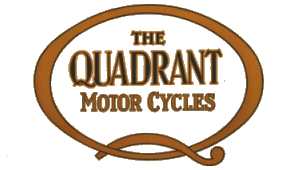


1889 Jan/Feb. Stanley Exhibition. Spring wheel for a cycle.
1890 Jan/Feb. The Stanley Exhibition of Cycles at the Crystal Palace. Illustrated.
1895 Became a limited company. The company was registered on 24 October, to take over a private business carried on under the same title.
1896/7 Directory: Listed under cycles.
1900/1901 The motorcycle side of the company was founded by Walter John Lloyd, who partnered with William Priest, and they were soon joined by Tom Silver. Lloyd's first design was fitted with a 211cc Minerva engine. This was followed by a forecar.
In May 1902 the address for The Quadrant Cycle Co., Ltd., was Sheepcote Street, Birmingham.
1903 The company had its own design of engine mounted in a loop frame. This design had a single lever to control the throttle, ignition switch, spark advance and valve lifter. That year Tom Silver set a new Land's End to John O'Groats record on a 3hp model, which boosted sales greatly.
1903 The Quadrant was first brought out at the end of the year, as a single speed machine, and was one of several makes of forecar that enjoyed a run of popularity at that time.
For 1904, a two-speed model was available, gear selection being made by the engagement of friction clutches to V-belt pulleys situated in the region of the bottom bracket. A curious arrangement of two air-cooled engines mounted side-by-side was employed, these being connected by a leather faced clutch when load conditions required the use of both. Final drive was by chain.
From 1903 onwards Quadrant produced their own engines in a wide range of capacities and types.
1904 A forecar model was added. This had two 2½ hp engines mounted side-by-side with a clutch in between, so one or both could be used.
1908 Having been revised, the company moved to from Birmingham to Earlsdon, Coventry, where they developed and produced many more models.
1910 Walter Bentley, known later for his cars, raced Quadrant motorcycles.
The lightweight deserves special notice for the reason that the engine is a small replica of its larger brother, a factor which makes also for simplicity and, therefore, reliability. The new spring fork, fashioned somewhat on the lines of the well- known Quadrant fork but now adapted to take a front brake, should also be noticed.
Post World War I to 1920. Only singles were produced - with a Sturmey-Archer gearbox.
1921 A new model appeared. This had a side-by-side valve engine and all-chain drive.
1922 A 624cc single was produced and the old Quadrant idea of placing the inlet valve at the back of the cylinder disappeared permanently. By December 1922 March, Newark & Co owned Quadrant, with the address given as Quadrant Works, 45 Lawley Street, Birmingham.
1924 The firm was producing two models only - a 490cc and a 624cc - both side valves. A 490cc ohv sports model joined the range, but was short lived.
A report on the Motor Cycle Show of November 1924 reads, in part,
The 3½ h.p. combination is the above machine with a light coachbuilt sidecar. A 4½ h.p. combination is also standardised, with a single-cylinder engine...
March, Newark & Co., Ltd., 45-49, Lawley Street, Birmingham.
1926 The sports model was redesigned and given twin exhaust ports. All Quadrant models now had a three-speed Burman gearbox.
1927 This was the final year of production for the firm that once advertised itself as the maker of 'Britain's Oldest Motor Cycle'. These machines had an enviable reputation as robust touring motorcycles, but manufacture ceased, even though the company had tried to modernize its line-up.
1928 The company closed.
Sources: Graces Guide, Motor Sport Magazine
If you have further information or a query related to this page, please contact us